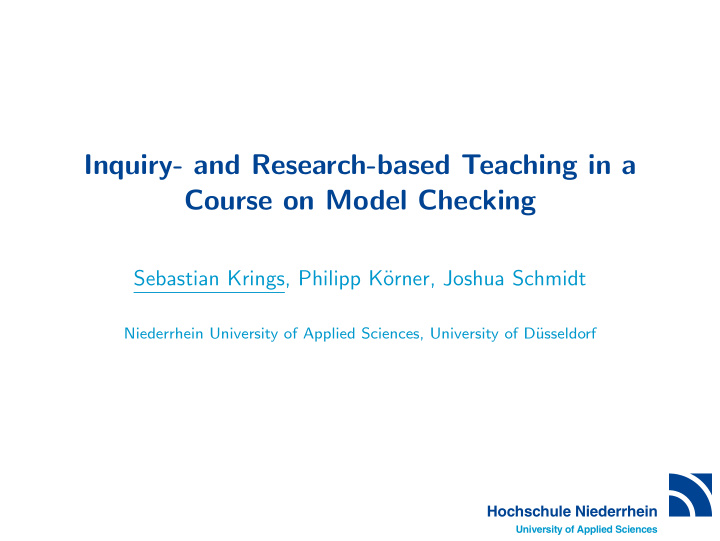



Inquiry- and Research-based Teaching in a Course on Model Checking Sebastian Krings, Philipp K¨ orner, Joshua Schmidt Niederrhein University of Applied Sciences, University of D¨ usseldorf Hochschule Niederrhein University of Applied Sciences
State of the Art • Model checking research connects theoretical and practical aspects • New algorithms are often implemented inside well-known model checkers ◮ In development for many years ◮ Complex ◮ Large code volume ◮ High entry barrier However This is seldom taken into account by university courses, which often remain on the theoretical level. Hochschule Niederrhein University of Applied Sciences
State of the Art ... Our course wasn’t any better. Hochschule Niederrhein University of Applied Sciences
State of the Art ... Learning objectives: • Students can present and compare different techniques • Students know common algorithms and can implement them • Students can summarize selected literature and are able to criticize • Students can write their own specifications and evaluate them So obviously A purely frontal lecture-based course is the way to go. Hochschule Niederrhein University of Applied Sciences
State of the Art ... Oh boy was our course missing the point. Hochschule Niederrhein University of Applied Sciences
Major Shortcomings • Learning results reduced due to missing hands-on experience • Scope of thesis topics is limited, as students have not learned how to appropriately address practical problems • Missing experience in project work, tool usage and working collaboratively ◮ Students do not meet expectations from industry ◮ Skills could be acquired en passant in a programming project Hochschule Niederrhein University of Applied Sciences
Course Redesign • High-level idea ◮ Acquire the theoretical foundations by identifying and analyzing common software errors ◮ Align these foundations with the body of knowledge ◮ Design and implement a novel model checker as independently as possible • Important aspects for success (Baron, et al.) ◮ Selecting appropriate learning goals ◮ Begin with problem-based learning before project work ◮ Enable self-assessment and revision ◮ Develop an atmosphere and social structures that support participation Hochschule Niederrhein University of Applied Sciences
Major Challenges • Cognitive requirements are higher ◮ Switch from knowledge reproduction to production • Progression is less linear • Individual workload is increased ◮ Motivation and commitment has to be increased • Research has to be controlled to avoid getting off track ◮ As much freedom as possible, but guarantee intended learning outcomes • Exams have to be prepared carefully to meet didactic requirements and exam regulations Hochschule Niederrhein University of Applied Sciences
Problem-based: Hazard Collection for Elevator Hochschule Niederrhein University of Applied Sciences
Problem-based: Sorted Hazard Collection Hochschule Niederrhein University of Applied Sciences
Course Sessions After problem-based introduction, iterate between • Project management • Implementation • R&D sessions • Reflection & evaluation sessions Hochschule Niederrhein University of Applied Sciences
Project Management: Kanban Hochschule Niederrhein University of Applied Sciences
Project Management: Kanban Hochschule Niederrhein University of Applied Sciences
Project Management: Kanban Hochschule Niederrhein University of Applied Sciences
R&D: Algorithm Development Hochschule Niederrhein University of Applied Sciences
Course Evaluation Different approaches to course evaluation • Peer review by other teachers • Direct student feedback • Grades • Learning data analytics Hochschule Niederrhein University of Applied Sciences
Grading • Exam should measure both theoretical and practical aspects • Ensure that grading complies with the examination regulations • Improve constructive alignment (Biggs, 1996): ◮ Formative part: constant participation documented using the Kanban board ◮ Attitude, soft skills observed but hard to grade ◮ Theoretical foundations by summative exam • Combined exam verifies learning objectives! Hochschule Niederrhein University of Applied Sciences
Grades 2014 2015 2016 2018 2017 # Students 2 5 7 6 5 ∅ Grade 1.85 2.58 1.71 1.28 1.88 Hochschule Niederrhein University of Applied Sciences
Evaluation: Additions and Deletions to Sources Hochschule Niederrhein University of Applied Sciences
Evaluation: Activity Hochschule Niederrhein University of Applied Sciences
Dissemination: SEUH Article Hochschule Niederrhein University of Applied Sciences
Last Step of Research: Publication • Not part of the course, as we could not reasonable expect anything • Still 3 students were interested • Outside of curriculum: ◮ Discuss publication process, peer review, etc. ◮ How to write interesting paper (mostly following Peyton Jones) ◮ Brainstorm possible topics and ideas ◮ Writing, meetups for synchronization Hochschule Niederrhein University of Applied Sciences
One Question Remains To what extent where our students doing relevant research? Hochschule Niederrhein University of Applied Sciences
Dissemination: Student Article Hochschule Niederrhein University of Applied Sciences
Conclusions • Goals met • Realization more hazzle-free than anticipated • Highly motivating for students, immediate sense of relevance • Scaling and proper knowledge propagation difficult Summary 10 of 10, would teach that way again. Hochschule Niederrhein University of Applied Sciences
Thank you! Any questions? Hochschule Niederrhein University of Applied Sciences
Recommend
More recommend